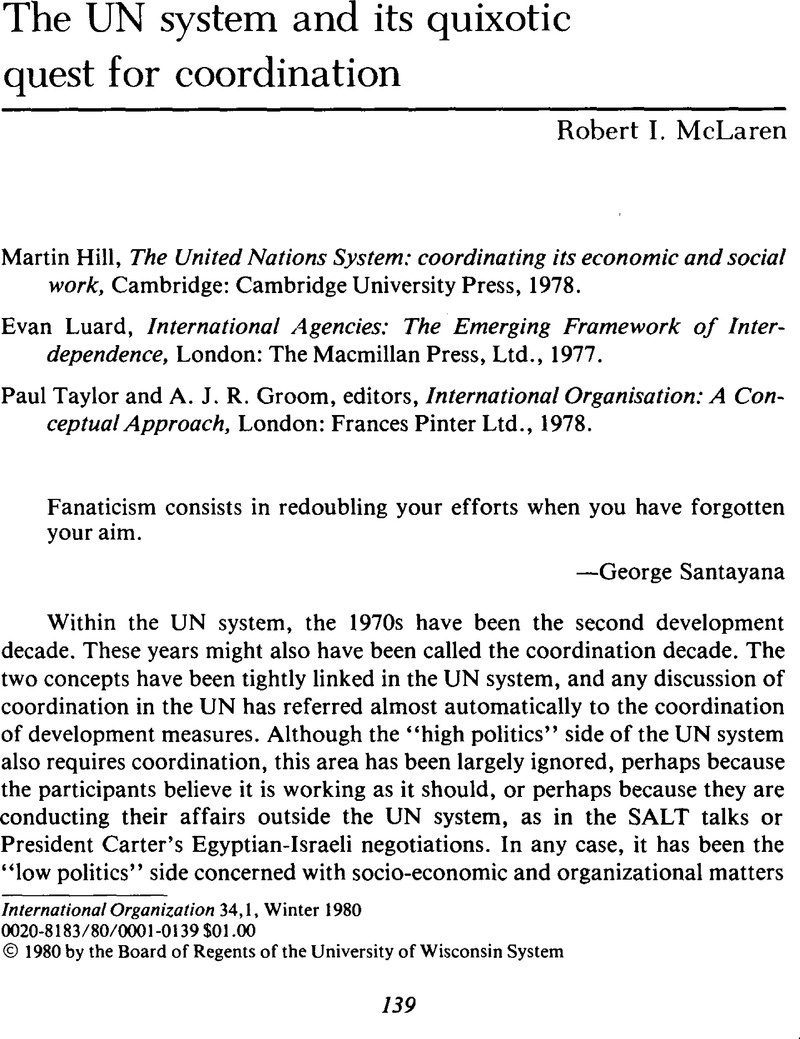Article contents
The UN system and its quixotic quest for coordination
Published online by Cambridge University Press: 22 May 2009
Abstract

- Type
- Review essay
- Information
- Copyright
- Copyright © The IO Foundation 1980
References
1 Barnard, Chester I., The Functions of the Executive (Cambridge, Mass.: Harvard University Press, 1964), p. 184.Google Scholar
2 For one treatment of this perspective, see Peter, Self, Administrative Theories and Politics (Toronto: University of Toronto Press, 1973)Google Scholar; for one view of the consequences of this perspective, see Richard, Rose and Guy, Peters, Can Government Go Bankrupt? (New York: Basic Books, Inc., 1978).Google Scholar
3 See, for example, Simon, Herbert A., Smithburg, Donald V., and Thompson, Victor A., Public Administration (New York: Alfred A. Knopf, 1950), passim.Google Scholar
4 This, and the following characteristics, can be noted in almost any study of bureaucracy, but see especially Anthony, Downs, Inside Bureaucracy (Boston: Little, Brown, 1967).Google Scholar
5 This conclusion is derived from personal interviews of officials and delegates in various Specialized Agencies, and from such documents as: United Nations, World Health Organization, Proposed Programme Budget for the Financial Years 1978 and 1979 (Official Records of the World Health Organization 236), 1977, p. 7.
6 United Nations, A Study of the Capacity of the United Nations Development System (Geneva: United Nations, 1969), Vol. 2, pp. 335–37.Google Scholar
7 United Nations, A New United Nations Structure for Global Economic Cooperation (Report of the Group of Experts on the Structure of the United Nations System, 1975), pp. 62–63.Google Scholar
8 United Nations, General Assembly, Report of the Ad Hoc Committee on the Restructuring of the Economic and Social Sectors of the United Nations System, A/32/34, pp. 25–26.Google Scholar
9 The classic statement appears in Simon, Herbert A., “The Proverbs of Administration,” Public Administration Review 6 (winter 1946): 53–67.Google Scholar
10 For example, Brown, R. G. S., The Administrative Process in Britain (London: Methuen & Co., Ltd., 1970), pp. 197–206Google Scholar. The non-hierarchists would dispute this requirement, but unfortunately, their diatribes against hierarchy have failed to recognize that it has advantages as well as disadvantages, so that their Utopian models have not come to fruition; see, for example, Thayer, Frederick C., An End to Hierarchy! An End to Competition! (New York: New Viewpoints, 1973).Google Scholar
11 Any introductory management text will expound upon these two concepts, planning and control; see, for example, James, A. F. Stoner, Management (Englewood Cliffs, N.J.: Prentice-Hall, Inc., 1978), pp. 108–151.Google ScholarPubMed
12 Holmes, John W., “A Non-American Perspective,” in The Changing United Nations: Options for the United States, Kay, David A., ed. (New York: Praeger, 1977), p. 38.Google Scholar
- 9
- Cited by


